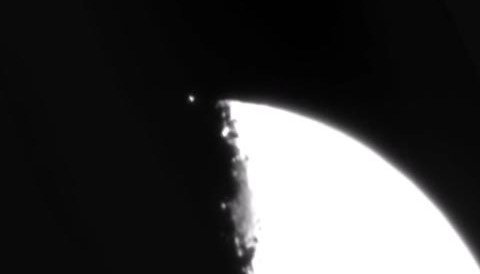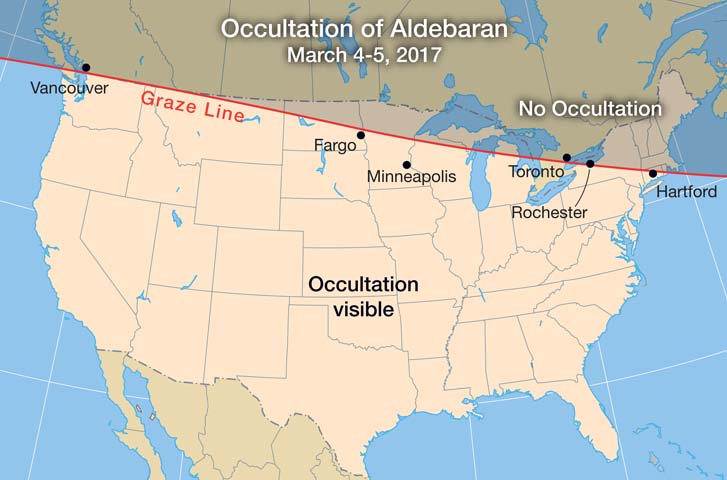A lucky group of Canadian observers got to witness remarkable events as the Moon slid past Aldebaran on the night of March 4th.
| On the night of March 4th (early March 5th as reckoned in Universal Time), skygazers across North America watched the Moon occult Aldebaran. Here's a report about that event from a veteran deep-sky observer who intentionally positioned himself along the event's northern limit, from which Moon's edge appeared to barely graze the star. |

Brad Timerson
The northern limit graze of Aldebaran this evening at Osoyoos, British Columbia, far exceeded my expectations. We had about 20 events over a period of 2 minutes 12 seconds. The reason that I say "about 20" is that sometimes the blinks were coming so fast that I could not keep up while shouting into my tape recorder.
The early part of the graze featured four slow fades. At the first two fades the star did not completely disappear before returning to full brightness! This constitutes resolution of the disk of the K5 giant star Aldebaran with the aid of the lunar limb. The latter part of the graze had four blinks when Aldebaran just reappeared for a mere fraction of a second in narrow gaps in the lunar terrain.
The first few events were on the dark part of the lunar limb, the rest on the bright limb. But, having observed many occultations of Aldebaran, I knew that the bright limb would not be a problem because Aldebaran is much brighter than any adjacent tiny part of the Moon — plus there is a strong color contrast between the orange star and the light yellow Moon.

Sky & Telescope / Lean Tiscione; source: IOTA
Many, many thanks to Brad Timerson of IOTA who calculated a lunar limb profile specifically for the longitude of Osoyoos. We had nine observers at longitude 119° 28.466′ west, latitude 49° 2.551′ north, elevation 304 m. All of us are people who enjoy this hobby as visual observers, so nobody gave up their eyepiece to a video camera.
At the Antares graze near Olympia, Washington, in July 2005 we had a north-south fence of observers because lunar grazes still had scientific value at that time. But those days are gone, at least for grazes of 1st-magnitude stars. So, instead of the traditional north-south line of observers — which means some get lucky and see multiple events, while others see only two events (one disappearance and one reappearance) — we all gathered together where Brad Timerson had indicated that the sweet spot should be. It's difficult to imagine that anywhere else around Osoyoos could have been blessed with as many slow fades.
I had eight events at that Antares graze in 2005, so "about 20" tonight was far beyond my hopes.
It is always wonderful when you know that you have just had an experience that will form a lifetime memory. Tonight’s grazing occultation of Aldebaran was one. I used my 80-mm apochromatic refractor at 67×. The sky was clear (as the Clear Sky Charts had forecast 11 hours earlier); the transparency was excellent; the seeing was above average; and the Moon’s altitude was 50°. The semi-arid climate of Osoyoos has one of Canada’s largest collections of private observatories, and our generally favorable climatology really came through for us this evening.
Click on the image below to see a video recording of the Aldebaran occultation made by Brad Timerson from near Rochester, New York, where the Moon's altitude was only 18° and the temperature was 1°F. Timerson has also compiled observing reports from the event.
 4
4
Comments
Justin S
March 8, 2017 at 5:14 pm
Wow! Incredible! Great job! I'm as impressed as all get out!
You must be logged in to post a comment.
Frank-ReedNavigation.com
March 8, 2017 at 7:26 pm
We had great views of the occultation here in Rhode Island despite the bitter cold. Here’s CBW’s wonderful video of the event:
https://www.youtube.com/watch?v=ObszAwMfqEg
You must be logged in to post a comment.
March 8, 2017 at 7:59 pm
Very nice! Here in West Virginia, I watched the Moon occult a star in the Hyades star cluster. I hadn't watched one before. It was fascinating to see the Moon moving toward the star, and the star just blink out. I used a Meade Mini Lightbridge 130 and a 15mm Plossl with a ND filter.
You must be logged in to post a comment.
andizottmann
March 9, 2017 at 6:01 pm
Fantastic! Congratulations! We had a grazing occultation of Aldebaran here in Bavaria, Germany 1 month earlier: https://www.youtube.com/watch?v=foVT89GzvKk&feature=youtu.be
You must be logged in to post a comment.
You must be logged in to post a comment.